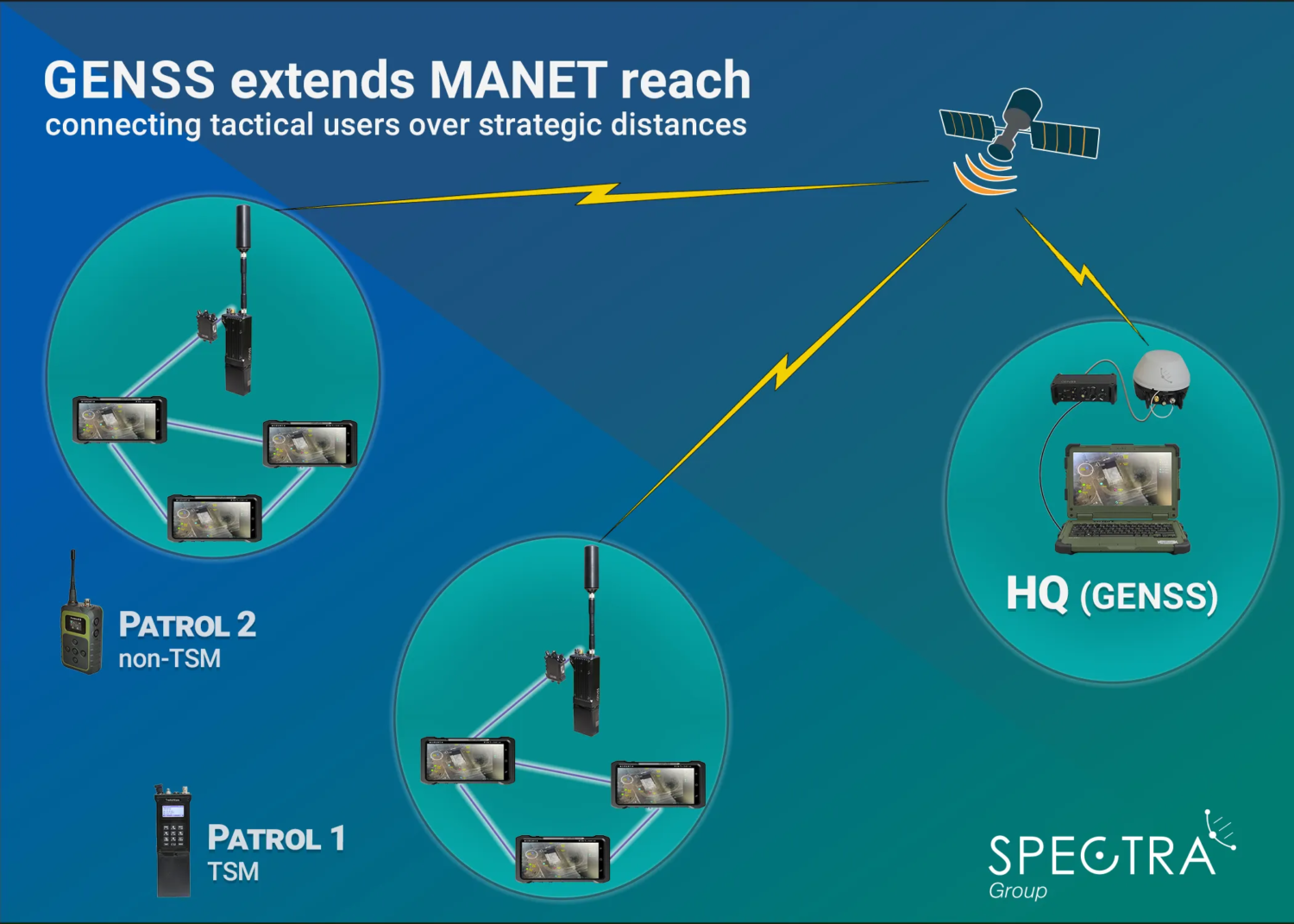Spectra Group and 2iC Deliver Breakthrough MANET-to-Satellite Connectivity
Spectra Group, a specialist provider of secure voice, data and satellite communications systems, is announcing at AUSA a unique Mobile Ad-hoc Network (MANET) bridging solution using GENSS — the first of its kind over a Beyond Line of Sight (BLOS) satellite link.
This tactical data solution, created in collaboration with software from 2iC, will deliver real-time strategic-level battlefield data via GENSS to remotely deployed tactical users.

GENSS Builds on the Legacy of SlingShot
Spectra’s SlingShot revolutionised tactical comms with over 10,000 systems fielded worldwide; GENSS builds on that legacy with even greater reach, flexibility, and data resilience. GENSS (Next Generation SlingShot) takes all the successes and lessons learnt from SlingShot and embodies Spectra Group’s vision of producing the ultimate radio system that capitalises on technological advances, adapts to the evolving demands of military operations and simplifies the user experience.
Delivering a Tactical Data Bridge for the Modern Battlespace
In addition to being backwards compatible with SlingShot and being a powerful satellite software defined radio (SDR) in its own right, the GENSS delivered solution uses enhanced modulation and waveforms optimised to deliver a Data Network/MANET bridging capability to cope with extending the proliferation of wide band data usage (64KBps over a 25KHz channel) in the tactical battlespace beyond normal Line of Sight propagation.
Integrating GENSS and 2iC Software for Seamless Data Flow
To maximise this ability to bridge MANET and other data networks, Spectra Group has collaborated with 2iC, a UK based global leader in battlespace software integration. Their lean service architecture and integration products are used by MODs and defence primes all over the world to quickly, easily and securely connect the myriad of disparate devices, sensors and systems on the battlefield digitally.
Enhanced Situational Awareness with GENSS and 2iC Middleware
Working together, Spectra Group and 2iC have delivered and continue to develop a series of ‘middleware’ applications, consisting of a combination of 2iCs operationally proven products such as 2iC NODE and TAK Module alongside the GENSS application software and its Open API radio firmware.
This combination allows for efficient data flow management to be delivered over narrow band L-TAC BLOS bearer systems and enable GENSS to be seamlessly interoperable with ATAK or other battlefield management systems. The end user gets a simplified and unified battle picture across multiple terminals/access platforms over vast distances while on the move.
Designed for Interoperability and Future-Proof Performance
This means that not only does GENSS retain ultimate flexibility and interoperability as a software defined radio, but it also has an open architecture construct able to easily integrate with existing systems and rapidly adapt to future demands.
Industry Leaders Comment on the Collaboration
Graham Booth, CEO and Co-founder of 2iC, said:
“We are very excited to bring our vast experience of delivering digital interoperability in the battlespace to our work with Spectra Group.
Our proven off-the-shelf software, such as 2iC CONNECT:TAK, alongside our extensive experience with ATAK, are proving invaluable.
Together we are developing bespoke software to maximise MANET capabilities and ensure GENSS is highly future proofed.”
Simon Perrett MBE, Head of Research and Development at Spectra Group, said:
“It is very rewarding when you can work together with subject matter experts from different disciplines and collectively the output is greater than the sum of the individual parts.
Working with 2iC, we are maximising the capability and ease of use of GENSS in its MANET bridging role, which is a massive benefit to the user on the ground and goes to the heart of our ethos at Spectra Group.
GENSS is a step change in tactical radio capability and for the soldier on the ground, GENSS will be plug-and-play; delivering secure, simplified access to mission-critical data BLOS and on the move.”








